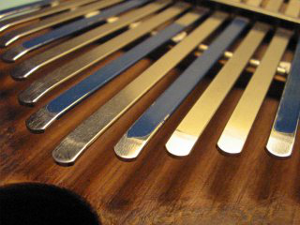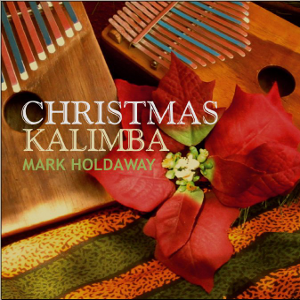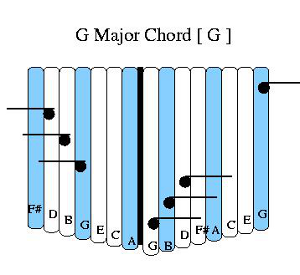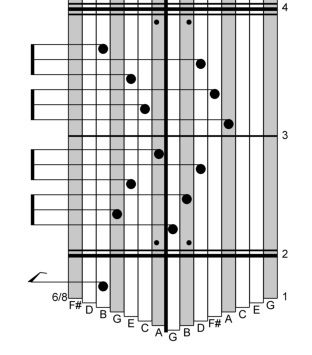Home > Waking Dream > My Kalimba Story
How the kalimba came into my life, how I got to be a good kalimba player, and how Kalimba Magic was born…
My Kalimba Story

I was two years old, my brother had just been born, and my family was visiting the home of his new godparents, Doug and Opal Desch. I was a handful, and Opal took me aside and showed me this cool little box with metal strips that made wonderful sounds: “Plink, plink, plink”. She smiled and said “It will be right here on the coffee table, and you can play it ANY TIME you want!” My eyes widened at the sound, and that little thumb piano did not leave my grasp the rest of the day. What a magical sound it made!. It made me feel that it could talk to me… but now I can’t remember what it said. Little Mark was no trouble to the grownups that day!
Many musical instruments came into my life: autoharp, recorder, trombone, guitar, piano. I grew up and went off to college. I remember in 1986, shortly after graduating, I was visiting some friends on Western Ave in Cambridge, Massachusetts, I spied a beautiful wooden box with metal tines. “Ah, a kalimba”, I said, and I held it and made it go “plink, plink, plink”, smiling all the while. Ten minutes later, in walked someone I had never seen before, who said “Ah, a KALIMBA!”, and in his hands the music box was transformed into an instrument of God, playing the most wonderful and amazing music, as rich and complex and full of light as the master Bach himself might have played. My mind was blown!
Within a week, I had gone out and bought myself a kalimba — a
Hugh Tracey kalimba to be exact. (The Hugh Tracey kalimba is not just the original musical instrument from Africa — it remains one of the best kalimbas commercially available.) I would spend the next 19 years chasing the memory of the heavenly music I had heard played in that Cambridge apartment. For the first ten of those years, I would wander in the wilderness, improvising and playing wild random things. My thumbs got to know the lay of the land pretty well. It was in 1996, in Boulder, Colorado, that I wrote my first kalimba song, “First Look Inside”. Simple, elegant, but moving and beautiful, this tune would become the centerpiece of my first kalimba
CD, “Two Thumbs Up” in 2000. I remember stopping time at a performance at Martha’s Black Dog, a pub in Socorro, New Mexico. The whole audience GOT IT! Even I GOT IT! Playing a beautiful, simple song on the kalimba could stop time! Anyway, I liked this tune so much, I put two different versions of it on the CD “Two Thumbs Up”. The title of this album really refers to that total joy and rightness that came into my heart during and immediately after that performance at Martha’s — it was just SO RIGHT!
 I’ve always liked playing Christmas carols, and in 2002 I decided to actually work on them and make something really wonderful happen. A few days after I signed up to play at the Tucson Kitchen Musicians Association holiday concert, I sat down on a bench to eat my lunch and prepare something for the performance, kalimba in one hand, paper and pen in the other. My lunch sat forgotten – my hands and brain were so busy. It was as if I was taking dictation from God; new kalimba arrangements for Christmas songs flowed out, one after the other. Jesu Joy of Man’s Desiring, Oh Holy Night, God Rest ye Merry, Gentlemen, Good King Wenceslas, O Come O Come Emanuel, Away in a Manger, and it went on and on. Only thirty minutes after I sat down, all the Christmas songs that were deeply meaningful to me had been melded into a splendid medley that told the Christmas story with full emotion and not one word. From that moment I knew that when I performed this music at the TKMA holiday concert, it would be a night that everyone would remember for the rest of their lives.
I’ve always liked playing Christmas carols, and in 2002 I decided to actually work on them and make something really wonderful happen. A few days after I signed up to play at the Tucson Kitchen Musicians Association holiday concert, I sat down on a bench to eat my lunch and prepare something for the performance, kalimba in one hand, paper and pen in the other. My lunch sat forgotten – my hands and brain were so busy. It was as if I was taking dictation from God; new kalimba arrangements for Christmas songs flowed out, one after the other. Jesu Joy of Man’s Desiring, Oh Holy Night, God Rest ye Merry, Gentlemen, Good King Wenceslas, O Come O Come Emanuel, Away in a Manger, and it went on and on. Only thirty minutes after I sat down, all the Christmas songs that were deeply meaningful to me had been melded into a splendid medley that told the Christmas story with full emotion and not one word. From that moment I knew that when I performed this music at the TKMA holiday concert, it would be a night that everyone would remember for the rest of their lives.
I worked on that medley every day, and perfected the transitions and emotional fullness of each song, learning to breathe joy into the notes and melodies. When the night of the performance came, I primed the audience to really pay attention – the tiny kalimba could easily be overlooked – and I launched into the slow, deep, and beautiful Jesu and O Holy Night, and the songs just kept coming and coming. The total silence I heard between the notes let me know that I held the audience in my loving hands. Through the whole medley, but especially in the triumphant, ecstatic Gloria in excelsis Deo and Joy to the World, I felt like a locomotive picking up speed on a steep grade, bringing the audience with me in a joyous crescendo. Around each bend, the audience must have felt “This is it”, but I would notch it up ever higher, until the final strands of The Christmas Song …”although its been said, many times, many ways (but never like THIS with a kalimba!), Merry Christmas, Merry CHRISTMAS, MERRY CHRISTMAS, To YOU!” — I was a marathon runner, crossing the finish line and winning the race on his very first try — the tears were streaming down my face, people jumped out of their seats, and the standing ovation lasted for three solid minutes!
One friend would later ask me “Did you make ANY mistakes in that piece?” Well, yes, I played notes I hadn’t intended to, but when you make mistakes on the kalimba, you just sort of roll with it. Even the mistakes sound good on this magical instrument. My friend Deb likes to describe that event by saying that I levitated the entire room! I had filled hearts with joy! People I had never met looked me up and sent me cards telling me that I had to do this MORE. I felt marvelously affirmed! Hey, this WAS what I was meant to do with my life, wasn’t it!
In 2004, I met Betty Edwards at one of my performances in Tucson AZ. It had been a few years since I had really done anything with the kalimba, and I wasn’t in a very good place personally. Betty really liked what I was doing. We talked for an hour. “You know, there isn’t ANYBODY out there who does what you do. You should be on television. You should be on A Prairie Home Companion. You are so filled with joy when you play the kalimba, it’s like the Holy Spirit is coming right through your body.” Well, of course I should have been on television, but there was the big question: ‘How to get from being depressed and unfocused, moving in 10 different directions at once, to being devoted to playing kalimba and making music that ends up on TV?’
Betty wouldn’t let me go, though. We talked about once a month. She has a unique view of time, does Betty. In her mind, I had already succeeded, I was ALREADY on A Prairie Home Companion. “You want to send your kids to college? You’d better play some more kalimba, Mark!” Well, so far I never have made it on to A Prairie Home Companion, but in Betty I had someone who believed in me and what I could do with the kalimba – at a time when I found it hard to believe in myself. So I went along for the ride – I started believing that I was already a huge success on the kalimba, and it was my job to smile and trust that the world would realize it. Listening to Betty’s dreams for me, I started to feel really good about playing the kalimba. Around Christmas of 2004, I started teaching kalimba to a few students, including Jordan McGary, a young teenager who needed something big to latch onto in his life. He really wanted to learn the kalimba and had a deep heart connection to the instrument, but he just couldn’t remember what I taught him from one lesson to the next. I solved that problem by inventing a new form of
Listening to Betty’s dreams for me, I started to feel really good about playing the kalimba. Around Christmas of 2004, I started teaching kalimba to a few students, including Jordan McGary, a young teenager who needed something big to latch onto in his life. He really wanted to learn the kalimba and had a deep heart connection to the instrument, but he just couldn’t remember what I taught him from one lesson to the next. I solved that problem by inventing a new form of
kalimba tablature — something simple, graphical, and intuitive that I could leave in his hands at the end of the lesson. With the tablature, Jordan could reproduce and practice the music on his own. The image above IS THIS IMAGE BELOW NOW? is my very first published tablature – yes, it is a little bit clunky. It looks so much better now! SEE THE NEW IMPROVED ILLUSTRATION, THIS IS HOW IT LOOKS THESE DAYS Right about then, I decided that I needed to write something about how to play kalimba. There wasn’t any good instructional material anywhere I could find; perhaps a book would get more people playing and feeling what I felt when I played. In 2006 Randy and Sharon Eaton collaborated with me to create the
In 2006 Randy and Sharon Eaton collaborated with me to create the
KTabS program – Kalimba Tablature Software. This program lets you enter the notes with a click of the mouse, and it plays each note as you enter it. It will play your tune for you when you’re finished too. KTabS makes creating tablature fast, efficient, accurate and fun. It is extremely helpful to me, and i might use it several times a day to capture my kalimba ideas and to arrange songs for the books and other materials I create to help you learn to play kalimba.
And then, one morning while pouring milk into my coffee, a waking dream filled my head and heart: a vision of me as the ambassador of the kalimba to the world! A vision of one million people, making music with their hands, with joy in their hearts and peace on earth. This was not Betty’s dream for me – this was my dream for myself, and it resonated very strongly. And I thought… with the tablature and the books I hoped to write, I could actually DO this – I could turn a million people on to the kalimba. Wow!
(Much later, I did a calculation – the kalimba has been around for over 1000 years in Africa, and lets just say that each year there were about 1000 new kalimba players in Africa. Surely in the early days there were fewer, but more recently there were more. That would be a total of about one million kalimba players over the history of the kalimba. The kalimba – or more precisely the kalimba’s traditional relatives in Africa – was often used, historically, to connect to the spirits of the ancestors. (In the present it is more symbolic than ceremonial.) By imagining a million new kalimba players, in a way I was inviting the souls of those million past African players to come and join us – to accompany us on this modern walk with their ancient instrument.)
But the really BIG kick came in June of 2005. I had just gotten back from Inter-Mountain Yearly Meeting, a week-long Quaker retreat at Ghost Ranch, New Mexico, and in my inbox was an e-mail that was marked “SPAM”. Just before deleting it, I noticed the subject line said “Maestro!” I thought to myself, “Hmm, do I know this guy? If not, perhaps I WANT to….”
The message was from Christian Carver, the director of AMI, African Musical Instruments, in Grahamstown, South Africa. (If Paul Harvey were telling this story, he would stretch it out: “…AMI, the maker of the…. Hugh…Tracey…kalimba! The instrument Mark Holdaway had been playing since 1986, the instrument he had first seen when he was 2 years old! And NOW, you know…. the REST of the Story! Paul Harvey…Good DAY!”)
Time stopped as I read Carver’s words. Someone had sent my kalimba CD,
“Two Thumbs Up”, all the way to AMI in South Africa. It had migrated to Mr. Carver’s desk, and he had LOVED IT! He wrote “I have no idea why nobody has pointed me in your direction yet. I am blown away by what you are doing with the Hugh Tracey kalimba!” Deep down, I already kind of knew I was one of the best kalimba players in the world; now the maker of the Hugh Tracey kalimba knew it too! It turned out that AMI had lost their distributor in the US, and sales were low, worldwide. If kalimba sales didn’t improve, AMI was considering ending kalimba production. As I heard and took in this information, I suddenly saw what my future life would be. I was going to write kalimba books, lots of kalimba books. I was going to give concerts and talks about the kalimba, and I was going to sell kalimbas for a living!
Needless to say, I jumped at the opportunity to help sell the Hugh Tracey kalimba. It was a no-brainer. This was what I was born to do, and I would do it with all my spirit and wisdom and love and joy. That was over 10 years ago, and I am far down the path that I first imagined while pouring milk into my coffee, and which I later saw vividly when Christian Carver described AMI’s situation to me.
The kalimba story continues to unfold day by day. It is my spiritual journey, my path. It is a rocket that has lifted off the launch pad and is rising up into the sky. It is my reason for being. It is a source of interest and joy. It is my daily bread, and my daily work, and on bad days it can be my daily grind, but one that I would not trade for anything. It will be my path until the day I leave this life for good, and I have so much more work to do. I did not find my reason for being until I was 43, but I found it. I hope this gives you a measure of inspiration, that if you have not found your reason, it may yet find you, at 23 or 43 or 63 or 93 – magic has no expiration date, and when it finds you, you will fly.
While the vision for Kalimba Magic was all mine, it is true that I never would have been in a position to create Kalimba Magic if not for Betty Edwards. She believed in me and my music at a time when I was so cynical it felt as if belief in my own musical abilities was pointless. I am so thankful to her – she gave me love and support. I also thank her husband Milo – not every husband would been so supportive of his wife being so supportive of a stranger. So I owe a lot to Betty and Milo. May this story be a light to all who need to be believed in, and also to all who are inspired to believe in someone else – your simple actions could change their lives forever.
Before I started Kalimba Magic, I would often search the internet for information that might unravel the mysteries of the kalimba, tell me of its origins or show me how to do something I had never thought of before, but each time I reached out, I was disappointed. At that time there was essentially nothing about the kalimba on the web. But I already knew there were hundreds of high caliber players, hundreds of knowledgeable people with precious, hard-won experience and ideas, who could teach me and others about the kalimba. With Kalimba Magic’s website I knew I could facilitate this give-and-take, and gradually Kalimba Magic became a real online presence. I watched things slowly grow, saw connections begin to form, and saw a kalimba network taking shape.
Now, KalimbaMagic.com is a central beacon of “kalimba-ness”. I share what I know and learn about the kalimba, but, equally important, this website is like a bookshelf onto which other masters, from anywhere at all, can put their information. Then the world is welcome to read whatever the bookshelf has on it at the time. More always comes. Within KalimbaMagic.com’s Kalimba Tips and within the Newsletters are 10 years’ worth of gems that others have brought to me, and I have shared them with the world.


Sign up for our newsletter and free resources with your email address:
We pinky promise not to spam you and to only send good stuff.
 Christmas in July 2025
Christmas in July 2025 Patriotic and American Music for Kalimba
Patriotic and American Music for Kalimba